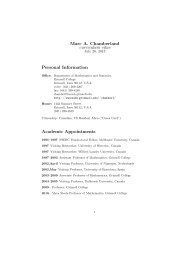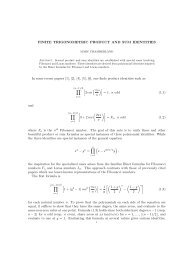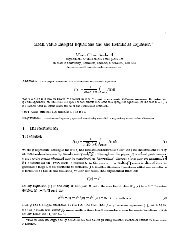An Update on the 3x+1 Problem Marc Chamberland Contents
An Update on the 3x+1 Problem Marc Chamberland Contents
An Update on the 3x+1 Problem Marc Chamberland Contents
Create successful ePaper yourself
Turn your PDF publications into a flip-book with our unique Google optimized e-Paper software.
4<br />
<strong>the</strong> help of numerical results like those in <strong>the</strong> last paragraph coupled with <strong>the</strong><br />
<strong>the</strong>ory of c<strong>on</strong>tinued fracti<strong>on</strong>s – see a secti<strong>on</strong> 5 for more <strong>on</strong> cycles.<br />
There is a natural algorithm for checking that all numbers up to some N<br />
iterate to <strong>on</strong>e. First, check that every positive integer up to N − 1 iterates to<br />
<strong>on</strong>e, <strong>the</strong>n c<strong>on</strong>sider <strong>the</strong> iterates of N. Once <strong>the</strong> iterates go below N, you are<br />
d<strong>on</strong>e. For this reas<strong>on</strong>, <strong>on</strong>e c<strong>on</strong>siders <strong>the</strong> so-called stopping time of n, that is,<br />
<strong>the</strong> number of steps needed to iterate below n :<br />
σ(n) = inf{k : T (k) (n) < n}.<br />
Related to this is <strong>the</strong> total stopping time, <strong>the</strong> number of steps needed to iterate<br />
to 1:<br />
σ ∞ (n) = inf{k : T (k) (n) = 1}.<br />
One c<strong>on</strong>siders <strong>the</strong> height of n, namely, <strong>the</strong> highest point to which n iterates:<br />
h(n) = sup{T (k) (n) : k ∈ Z + }.<br />
Note that if n is in a divergent trajectory, <strong>the</strong>n σ ∞ (n) = h(n) = ∞. These<br />
functi<strong>on</strong>s may be surprisingly large even for small values of n. For example,<br />
σ(27) = 59, σ ∞ (27) = 111, h(27) = 9232.<br />
The orbit of 27 is depicted in Figure 1.<br />
Roosendaal[65](2003) has computed various “records” for <strong>the</strong>se functi<strong>on</strong>s 1 .<br />
Various results about c<strong>on</strong>secutive numbers with <strong>the</strong> same height are catalogued<br />
by Wirsching[87, pp.21–22](1998).<br />
2.1 Stopping Time<br />
The natural algorithm menti<strong>on</strong>ed earlier can be rephrased: <strong>the</strong> 3x + 1 problem<br />
is true if and <strong>on</strong>ly if every positive integer has a finite stopping time. Terras[77,<br />
1 Roosdendaal has different names for <strong>the</strong>se functi<strong>on</strong>s, and he applies <strong>the</strong>m to <strong>the</strong> map<br />
C(x).





